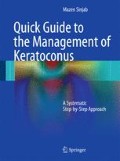Abstract
Classification of KC is the first step in approaching the disease because the severity of the disease and the stage at which the patient is diagnosed and treated affect treatment results. KC can be classified according to the morphology of the cone and the pattern of corneal topography.
Access this chapter
Tax calculation will be finalised at checkout
Purchases are for personal use only
Bibliography
Alpins N, Stamatelatos G (2007) Customized photoastigmatic refractive keratectomy using combined topographic and refractive data for myopia and astigmatism in eyes with forme fruste and mild keratoconus. J Cataract Refract Surg 33:591–602
Colin J, Velou S (2003) Current surgical options for keratoconus. J Cataract Refract Surg 29:379–386
Ertan A, Colin J (2007) Intracorneal rings for keratoconus and keratectasia. J Cataract Refract Surg 33:1303–1314
Fogla R et al (2003) Keratectasia in 2 cases with pellucid marginal corneal degeneration after laser in situ keratomileusis. J Cataract Refract Surg 29:788–791
Gruenauer-Kloevekorn C et al (2006) Pellucid marginal corneal degeneration: evaluation of the corneal surface and contact lens fitting. Br J Ophthalmol 90:318–323
Holladay JT (2008). Detecting forme fruste keratoconus with the Pentacam. Supplement to cataract & refractive surgery today Feb: 11,12
Karimian F et al (2008) Topographic evaluation of relatives of patients with keratoconus. Cornea 27:874–878
Kubaloglu A et al (2010) A single 210-degree arc length intrastromal corneal ring implantation for the management of pellucid marginal corneal degeneration. Am J Ophthalmol 150:185–192
Lee WW et al (2007) Ectatic disorders associated with a claw shaped pattern on corneal topography. Am J Ophthalmol 144:154–156
Lim L et al (2007) Evaluation of keratoconus in asians: role of orbscan II and tomey TMS-2 corneal topography. Am J Ophthalmol 143:390–400
Mularoni A et al (2005) Conservative treatment of early and moderate pellucid marginal degeneration. A new refractive approach with intracorneal rings. Ophthalmology 112:660–666
Oie Y et al (2008) Characteristics of ocular higher-order aberrations in patients with pellucid marginal corneal degeneration. J Cataract Refract Surg 34:1928–1934
Piñero DP et al (2009) Refractive and corneal aberrometric changes after intracorneal ring implantation in corneas with pellucid marginal degeneration. Ophthalmology 116:1656–1664
Rasheed K, Rabinowitz YS (2000) Surgical treatment of advanced pellucid marginal degeneration. Ophthalmology 107:1836–1840
Santo MR et al (1999) Corneal topography in asymptomatic family members of a patient with pellucid marginal degeneration. Am J Ophthalmol 127:205–207
Sinjab MM (2009) Corneal topography in clinical practice (pentacam system): basics and clinical interpretation. Jaypee Brothers Medical Publishers, New Delhi
Sinjab MM (2010) Step by step reading pentacam topography (basics and case study series). Jaypee-Highlights Medical Publishers, New Delhi
Sridhar MS et al (2004) Pellucid marginal corneal degeneration. Ophthalmology 111:1102–1107
Tang M et al (2005) Characteristics of keratoconus and pellucid marginal degeneration in mean curvature maps. Am J Ophthalmol 140:993–1001
Author information
Authors and Affiliations
Corresponding author
Rights and permissions
Copyright information
© 2012 Springer-Verlag Berlin Heidelberg
About this chapter
Cite this chapter
Sinjab, M.M. (2012). Classifi cations and Patterns of Keratoconus and Keratectasia. In: Quick Guide to the Management of Keratoconus. Springer, Berlin, Heidelberg. https://doi.org/10.1007/978-3-642-21840-8_2
Download citation
DOI: https://doi.org/10.1007/978-3-642-21840-8_2
Published:
Publisher Name: Springer, Berlin, Heidelberg
Print ISBN: 978-3-642-21839-2
Online ISBN: 978-3-642-21840-8
eBook Packages: MedicineMedicine (R0)

